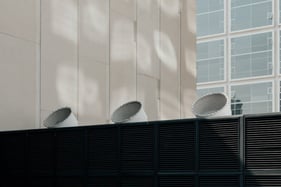What a wild ride! It started to look like the worst of the pandemic was behind us, and businesses were cautiously reopening responsibly and removing restrictions. Then the Delta variant came and changed everything.
It is time to pivot yet again.
While some businesses have been able to reduce the number of personnel in their building by encouraging employees to work remotely, many businesses still need employees in their facilities.
This means your frontline employees are now at an increased risk of infection.
You may have already implemented office designs to help minimize physical contact and safety protocols to better protect employees without impairing work productivity. That is a good start.
However, COVID-19 and all its variants have made it even more important for businesses to pay a lot of attention to their indoor air quality and ventilation. One of the variants, the Delta variant, is much more contagious with a viral level 1000 times greater than the original Alpha variant of COVID-19. This makes it much more contagious as these viral microorganisms can easily make their way through the air in your facility.
But what if you do not own your facility? What if you are dependent upon a landlord for major renovations, including heating, ventilation, air conditioning (HVAC), and indoor air quality (IAQ)?
IAQ has been a lingering issue
Before the pandemic, poor indoor air quality was a major issue for some businesses. While modern workplaces need to regulate indoor temperature to keep customers and staff comfortable, limiting air exchange between the inside of a building and the outside comes at a cost.
As a rule, enclosed spaces – offices, shops, and other workplaces – have higher concentrations of air pollutants than the air outside them. That’s because, to maintain the temperature at the desired level, the building traps air and keeps it from circulating to the outside. The result is a dangerously high buildup of harmful substances in the indoor air.
This has been quite a common issue with enclosed spaces, but with the arrival of the Coronavirus, the problem has become even worse. Limiting air exchange between a building and its environment exposes building occupants to a greater risk of respiratory illness.
However, some businesses don’t have full control of their HVAC and ventilation because they do not own their facility. With rent and lease agreements, you will need to work with your landlord to solve this problem. What should you know before you do this?
Work with your landlord to improve indoor air quality in your building
Indoor air quality (IAQ) does not depend solely on building design and HVAC maintenance. While those are very important, cleanliness, janitorial services, and disinfection methods also affect indoor air quality. The air quality can also be influenced by the materials used for office furnishings and items brought into a building by tenants.
Good indoor air quality comes from the joint effort of landlords and tenants.
Ensuring good air quality is everyone’s business.
You may not realize this, but “poor air quality will affect the landlord’s rental business as well as the performance of your business”, warns North County Property Group. “There are things only the landlord can do to ensure good air quality. There are also things the tenants must be responsible for. Therefore, the best results occur when landlords and tenants mutually support one another in their respective roles.”
As a tenant and business owner, here are some steps you should take to ensure good air quality for your business premises:

Require and participate in HVAC redesign, operation, and maintenance
The building will probably need retro-commissioning, existing HVAC systems should be evaluated, and problems that compound indoor quality issues, as well as, opportunities to improve IAQ should be identified. This will help bring the building up to speed with current regulations.
Encourage your landlord to adopt EPA/NIOSH guidelines
The EPA/NIOSH document on preventing and solving indoor air quality problems is probably the most up-to-date document of its kind. Encourage building management to adopt the principles and steps contained in this guide, and it will help solve most of the building’s IAQ problems.
Ask the landlord to install systems for monitoring and improving IAQ
Air quality can depreciate without leaving visible signs; poor air quality is not always accompanied by outward evidence. You need technology to help you monitor indoor air quality in real time. Alternatively, you can ask the landlord to install HEPA filters and/or ultraviolet UV-C light technology inside the HVAC system to capture and/or kill viruses that are circulating in the air.
Pay attention to equipment maintenance
Depending on the type of HVAC and your lease terms, you may or may not be involved in HVAC maintenance. But regardless of the specifics of the lease, you should not leave HVAC maintenance completely to the owner.
Make sure your HVAC maintenance is done on schedule and to specifications. This will not only keep your building at a comfortable temperature but also improve the filtration of the air. It may also improve utility management and reduce costs because the HVAC system will be operating optimally.
Monitor and manage occupancy levels

The HVAC in your building only has enough capacity to manage a certain occupancy level. If the number of people in a room exceeds what the system can effectively handle, the HVAC will not be able to cycle out CO2, germs, viruses, and other air pollutants at a fast enough rate to keep people safe.
Factor IAQ into management decisions
Chemical emissions from everyday items you use in the office can severely impact indoor air quality. Before you use chemicals in the office, find out how their constituent materials will impact indoor air quality. Have suppliers, contractors, or your facilities management team provide this information and verify claims beforehand.
Install additional equipment to remove air pollutants
For some businesses, it is almost impossible to completely avoid air pollutants in the workspace. If your business generates pollutants in the normal course of its work - common with printing and photography businesses - installing exhaust ventilation systems will make the area safer for your staff and visitors.
Use appropriate pest control when necessary
Maintaining good indoor air quality means being more creative when dealing with a pest infestation in the building. Instead of defaulting to the use of pesticides that linger in the air and hurt people and the environment, give priority to prevention and natural pest control methods.
During these uncertain times, quickly pivoting and expanding health-related tasks can put a lot of strain on your facilities management personnel.
When changing office uses, updating maintenance, and other safety precautions need to be addressed, having a great IFM partner to be a “force multiplier” should be part of your healthy facility strategy.
Flagship can provide the skills and people you need at your site. We have an infrastructure designed to support both as-needed staffings for project work and full-time FM staff.
We have experienced and professional teams ready to help your business with your IoT requirements and your integrated facilities management needs.
If you have any questions, please email a facilities expert and get the help you need to create and maintain a healthy facility.





Leave a Comment